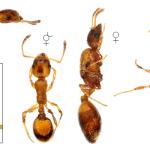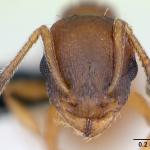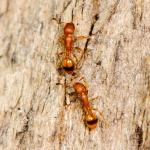This species previously included in the genus Leptothorax (Myrafant) is now placed in the genus Temnothorax (Bolton 2003). The small brownish-yellow workers of T. unifasciatus may be distinguished from those of the three similar British and Channel Islands species - T. albipennis, T. interruptus and T. nylanderi - by their possession of a clearly-defined, continuous dark band across the first gastral tergite.
Temnothorax unifasciatus occurs in the Channel Islands, but is absent from England, Wales, Scotland and Ireland except for a single record from West London, see above photo, a probable accidental import. Elsewhere, T. unifasciatus is found throughout southern, western and central Europe, and in parts of Eastern Europe. It has also been recorded from Morocco and southern Sweden (Collingwood 1979; Czechowski, Radchenko & Czechowska 2002).
The Channel Islands are not included in assessments of conservation status by either Shirt (1987) or Falk (1991).
In the Channel Islands T. unifasciatus colonises both coastal and inland sites (Orledge, Smith & David 2000) which are warm, dry and open, and where it has been found among rocks and under stones. Elsewhere, nests are found not only in rock crevices and under stones, but also in dead tree branches, under bark and in hollow plant stems (Collingwood 1979; Czechowski, Radchenko & Czechowska 2002).
Nests contain winged sexuals in July and August. Mating flights occur during the hour before, and the hour after, sunrise (Plateaux 1984).
Each nest has a single queen, and typically contains 200 or more workers. While the queen is present the production of males by workers is minimal (Heinze, Puchinger & Hölldobler 1997). Where T. unifasciatus and T. albipennis occur together in Europe they interbreed, and there is some evidence that the resulting hybrid colonies are able to reproduce (Douwes & Stille 1991). However, laboratory crosses between these species have produced only a few small, short-lived workers, and no sexuals (Plateaux 1984). As yet, there are no records of T. unifasciatus and T. albipennis occurring together in the Channel Islands (Orledge, Smith & David 2000).
2020





